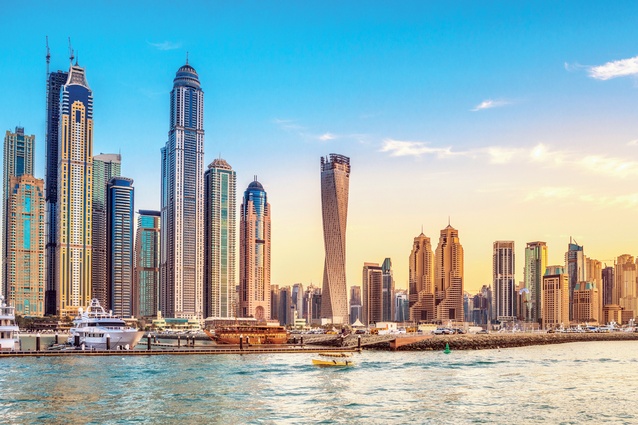Architecture as weaponry
Ahmed Yousef suggests that “the power of an idea can change people, impact history and, of course, metamorphose into architecture.” He explores examples of how governing bodies have planted their intended, supposed ideals carefully into the minds of the general public through architecture, and its effects, from ancient through to recent times.
Architecture’s relevancy to the realm of politics is fundamental; it often casts a monolithic shadow of influence that is, at times, too large for people to see. It is constantly changing and adapting in accordance to the political decree and the overriding ideological principles which are occupying that region: an aesthetic transformation in conformity to the ruling governing body and what that body desires the aesthetic to be; and influencing people with ‘architecturalised’ propaganda. Some might see it as a tangible tool, changing people in intangible ways: chiselling a subconscious indentation that the occupants who inhabit it are usually not aware of. However, these indentations, subtle as they may be in the changes they create in this present age, still have the capability to alter drastically people’s behaviours, ideals and overall thought processes. This effect can even create factions of people who would dedicate themselves to several causes.
This concept of dedication can become tremendously powerful, even dangerous. The power of an idea can change people, impact history and, of course, metamorphose into architecture. Creating extraordinary achievements that serve as reminders of what once was, these architectural achievements can be used also as tools of control, even intimidation, convincing and carefully planting their intended, supposed ideals into the general public. Once these are planted, the people’s perceptions of their surroundings change; they become adaptive to their created environment and they become accustomed to it. This ultimately gives people what one would call a false sense of control. To take the current architectural guideline as an example, one might ask “who are these guidelines benefiting?” – the people, the urban environment they inhabit or the Government̓s vested interests.
If one closely observed ancient Rome’s architecture, one would realise that it was used as a vital weapon in order to advance the power of the state. Rome’s giant concrete statements were designed to intimidate and overwhelm. They were created with community gatherings in mind; large spaces where significant numbers of people could congregate came first and foremost. The overwhelming greatness of these buildings, in terms of colossal size and complex design, confirmed and enforced the nation̓s iron-clad ideologies. The Roman Empire believed that the atmosphere of the buildings created would directly coincide and were crucial to how the public would respond to their speeches and messages. Another clear, recent example of this would be Dubai: a city, which was once almost non-existent during the ’80s and is now the prime example of what the future of metropolises can be. Through Dubai’s example, we gain insight into the strategy of the ruling body via architecture in order to entertain, revive traditional values, gain support for the government’s campaigns and encourage unity. This is not to mention, above all, its strategy to portray not only the ruler but the entire royal family as strong, moral leaders who are faithful to the people. Immense architectural achievements are created in an attempt to gain the loyalty and support of the masses and leaving the consumption of the energy used to create these monuments as a secondary issue. Whilst the Burj Khalifa and the Dubai Marina, which is currently under construction, might be incredible feats of engineering and push the boundaries of design, they do come at a staggering price, financially and environmentally.
There was a time when structures which embodied the sustainable approach and challenged the boundaries of urban design were hailed as the most revered architectural achievements. Now they’ve become the banks, corporate establishments and other business-oriented buildings, which are widespread. One could dispute that this happened thanks to architects’ altered perspectives: going from dedicating themselves to environmentally conscious or ‘utopian’ design choices that would benefit the urban living space as a whole, to dedicating themselves to self-indulgence and egotistical expression in an attempt to create potentially branded names. This, of course, creates a sense of security for most architects and comes from currency and monetary assets: placing, for each of them, the goal of becoming a starchitect above all else. Architecture should not be a personal pursuit of fulfilling one’s ego; it should be a necessary, maternal form of art which is beneficial for everyone in society. Instead, only the privileged one per cent reaps the rewards; the rich seem to be the only ones benefiting from what one would call architectural vanity projects, whilst conscious urban and suburban design slowly erodes. This is happening all across the globe, even in our own Aotearoa.
The recent plan to auction off state housing would have been the ideal way to introduce several opportunities to create sustainable communities and build a new foundation of environmental consciousness for the general public. Instead, what has been done directly contributes to the process of gentrification and the creation of slums, causing further classist separation and, potentially, erasing the middle class entirely: edging our communities further apart. Approximately 90 houses in Waterview were either demolished or removed to enable the creation of a new-ring road motorway connection; there are many more plans to further ‘enhance’ Auckland’s motorways, starting with places such as Glen Eden. This expansion was not part of the surrounding residents’ plans; the motorways were plans initially made by central government, produced out of its need to mould the people’s demands rather than respond to them. Christchurch is another crucial example of how the Government could have taken what was a major tragedy and morphed it into a golden opportunity for the benefit of the citizens. Instead, the plans for the city have been under a dense fog for quite some time now and the political football that is CERA has taken over the rebuilding process. It is seen to be the least-transparent government organisation, reputed to be withholding information from the public deliberately.
It seems that values in architectural planning are eroding. Designers claim their embracement of the sustainable approach; yet, what is usually created is not designed particularly to withstand a prolonged period of time nor made to benefit future generations. It is merely approaching buildings as recyclable materials and not as vital elements in the enhancement of living standards nor as part of a more sustainable world for future generations. However, if we are to take a look at overseas projects such as the Makoko School by NLÉ Architects in Nigeria, and designers such as Kunlé Adeyemi, we can see that vital steps are being taken in the environmentally conscious direction. With the creation
of projects such as the Makoko Floating School as a prototype floating structure, NLÉ displays the adaptive potential of architecture, regardless of the region̓s challenging environment. It takes into consideration the community’s fundamental needs for interaction whilst addressing issues such as climate change and the rapid urbanisation of Nigeria. Its key goals seem to be: generating a sustainable alternative building system, using adaptive construction techniques and focusing on the use of recyclable materials. As fundamental as these goals can be, without creating a ripple of change and altering the way we look at permanent architectural structures in accordance with the sustainable philosophy, we will not be able to transcend the selfish building methods to which we have become accustomed.
If architects keep looking at the residents who inhabit their structures as mere statistics, then change will not occur. We must come to the realisation that politics is architecture, and architecture is politics. Governments topple, individual leaders can fall and become forgotten or shunned by the societies of which they are in charge; however, architecture can leave a footprint of either decadence or excellence for the people. It is forever adaptive and an architectural achievement can still alter people̓s perspectives and make them contemplate what these structures̓ purposes were and what remains, making them question the people who have placed them and what their motives were in the first place. It is time for architects to realise the overwhelming weight of such a duty and its direct impact, and use their bestowed privilege for the benefit of others.











